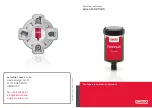
Page
13
|
Visit support.hunterindustries.com
3. Blowout Procedure
NOTE:
This procedure should be
performed by a licensed contractor
only. Always wear proper PPE;
compressed air can cause serious
injury including eye injury from
flying debris. Avoid standing over
any irrigation components (e.g.,
sprinklers, valves, piping) while using
compressed air in the system.
A. Open a zone and/or quick coupler(s).
B. Ensure air supply hoses are properly
connected to the air compressor fittings
on the irrigation system.
C. Start the compressor and open the air
supply valve on compressor slowly to
begin introducing compressed air into the
system.
D. Regulate air pressure so the maximum
pressure does not exceed the rating of
the weakest component in the system.
Volume, measured in cubic feet per
minute (CFM) or cubic meters per
minute (m³/min), is more important than
pressure to displace water in the system.
E. Once mostly air is coming from any open
drains and/or quick couplers, they may
be closed.
NOTE:
Always ensure that a zone
or quick coupler is open at all times
when compressed air is moving
through the irrigation system.
F. Activate each zone manually from the
controller to evacuate water. Once only
a very fine mist is coming out of each
sprinkler head on the zone, move to the
next zone. Avoid prolonged running of
zones that are dry to avoid damaging
sprinklers.
G. Repeat the process running through each
zone a second time to confirm all water is
removed from the system.
H. Turn off the air supply with the last
zone still running. Allow the pressure to
completely expel before disconnecting
air hoses.
I. Close any open drains and remove any
quick coupler keys from the system.
Make sure there are no points of entry for
debris to enter the system.
Fall Winterization
1. Water Source/Pumping System
A. Turn off main water supply and inlet/
outlet valve on interior mounted backflow
devices.
TIP:
Tag these valves so they are
not inadvertently opened during
freezing temperatures.
B. Turn off power to pump(s).
C. Open any drains on the water source and
pump(s) and leave them open.
D. Remove exterior water meters and
backflow devices if required.
E. Open any drain valves and quick couplers
in low points of the system. This allows
water to drain from the piping and
reduces the time required for system
blowout.
F. Open high points in the system (including
quick couplers if applicable) to allow air
into the system.
2. Air Compressor Connection
A. Connect the compressor to the irrigation
system at the designated point of
connection. If this is not available,
the correct compressor fitting must
be installed. To avoid damage to the
piping system due to overheating, the
use galvanized pipe to dissipate heat
prior to entering the irrigation system is
recommended.
B. Avoid blowing air through water meters,
flow sensors, and backflow devices; the
air connection should be downstream of
these items.
OFF
Water enters through valve filter screen and
pressure holds the
diaphragm
closed.
ON
Pressure vents through the selector switch
manifold, which allows the inlet valve
diaphragm
to open and water to flow up to
the riser and nozzle.
Winterization
To riser
and nozzle
To selector
switch
manifold










































